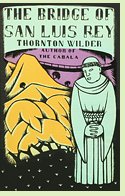The Bridge of San Luis Rey
by Thornton Wilder
Reviewed by Margaret Donsbach Tomlinson

Set in eighteenth-century Peru, The Bridge of San Luis Rey explores whether "we live by accident and die by accident, or we live by plan and die by plan." The fictional laboratory is a centuries-old rope bridge across a gorge which five travelers are crossing when it suddenly breaks without warning, flinging them to their deaths. Watching is Brother Juniper, a Franciscan friar who longs to prove God's benevolence by scientific demonstration. He investigates the travelers' lives; later, an unnamed narrator relates their stories at a deeper, more psychological level: the widowed marquesa who loves her daughter with suffocating intensity; her servant; a twin who falls hopelessly in love with an actress; the man who trained the actress in her craft; and the actress's illegitimate son. Their stories are told in three separate sections, each ending on a note that suggests a completed life-arc; so intertwined are their lives, though, that the novel functions as a single, cohesive work.
The historic Peruvian setting comes across vividly, but the real fascination for readers is trying to ferret out the distinction between Brother Juniper's briefly described project, which "resembled the effort of those presumptuous souls who wanted to walk on the pavements of Heaven and built the Tower of Babel to get there," and the narrator's subtler, less didactic approach. The friar's massive compilation of evidence did not gain the approval of the church, which declared his book heretical and burned it; the narrator appeals to modern readers, more tolerant of ambiguity.
A fictional work can never supply the "proof" Brother Juniper sought; so what is the novel's purpose? Wilder said he was inspired by "friendly arguments" with his strict Calvinist father. If people's deaths are indeed brought about by divine plan, is the plan to punish sin or to inspire love and forgiveness? The Bridge of San Luis Rey leaves the question unanswered, but the complex tapestry it weaves offers a strong hint to the author's sympathies. (1927, available in numerous editions, most between 110 and 150 pages; won the 1928 Pulitzer Price for fiction)
More about The Bridge of San Luis Rey at Powell's Books or Amazon.comOther novels set in Peru:
City of Silver by Annamaria Alfieri (2009), a mystery featuring the mother superior of a convent in the silver mining city of Potosí, Peru, in 1650, who must find out how a novice nun died amid a visit from Spain's Grand Inquisitor. See review or more info at Powell's Books
The Book of Human Skin by Michelle Lovric (2010), about a fanatical girl who arrives at a convent in Peru after a devastating 1784 earthquake, and a mistreated Venetian girl who refuses to become a victim. More info
The Sword and the Sun by Gerald Green (1953), about the effects of the Spanish Civil War in Peru during the 1930s. More info
Nonfiction about Peru:
Colonial Habits: Convents and the Spiritual Economy of Cuzco, Peru by Kathryn Burns (1999). More info
Sin and Confession in Colonial Peru by Regina Harrison (2014). More info
Deviant and Useful Citizens: The Cultural Production of the Female Body in Eighteenth-Century Peru by Mariselle Melendez (2011). More info
At the Movies:
The Bridge of San Luis Rey
Online:
Trailer of the 2004 film of The Bridge of San Luis Rey at YouTube
Back to Novels of Latin America
Back to Directory of Book Reviews